child lock CHEVROLET BLAZER 1998 2.G Owners Manual
[x] Cancel search | Manufacturer: CHEVROLET, Model Year: 1998, Model line: BLAZER, Model: CHEVROLET BLAZER 1998 2.GPages: 416, PDF Size: 22.4 MB
Page 31 of 416
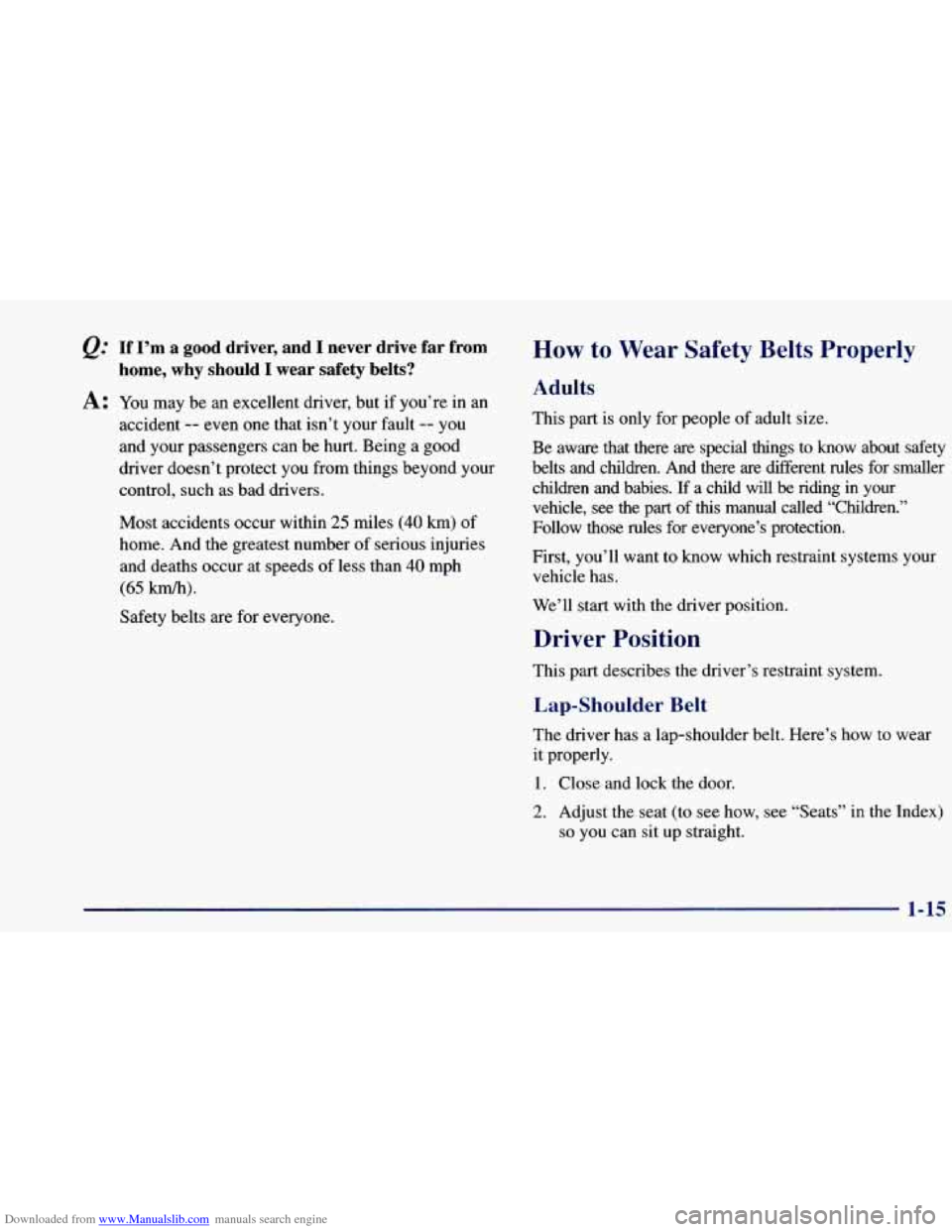
Downloaded from www.Manualslib.com manuals search engine &: If I’m a good driver, and I never drive far from
home, why should
I wear safety belts?
A: You may be an excellent driver, but if you’re in an
accident
-- even one that isn’t your fault -- you
and your passengers can be hurt. Being a good
driver doesn’t protect you from things beyond your
control, such as bad drivers.
Most accidents occur within
25 miles (40 km) of
home. And the greatest number of serious injuries
and deaths occur at speeds of less than
40 mph
(65 km/h).
Safety belts are for everyone.
How to Wear Safety Belts Properly
Adults
This part is only for people of adult size.
Be aware that there are special things to know about safety
belts and children. And there are different rules for smaller children and babies. If a child
will be riding in your
vehicle, see the part of
this manual called “Children.”
Follow those rules for everyone’s protection.
First, you’ll want to know which restraint systems your
vehicle has.
We’ll start with the driver position.
Driver Position
This part describes the driver’s restraint system.
Lap-Shoulder Belt
The driver has a lap-shoulder belt. Here’s how to wear
it properly.
1. Close and lock the door.
2. Adjust the seat
(to see how, see “Seats” in the Index)
so you can sit UD straight.
1-15
Page 39 of 416
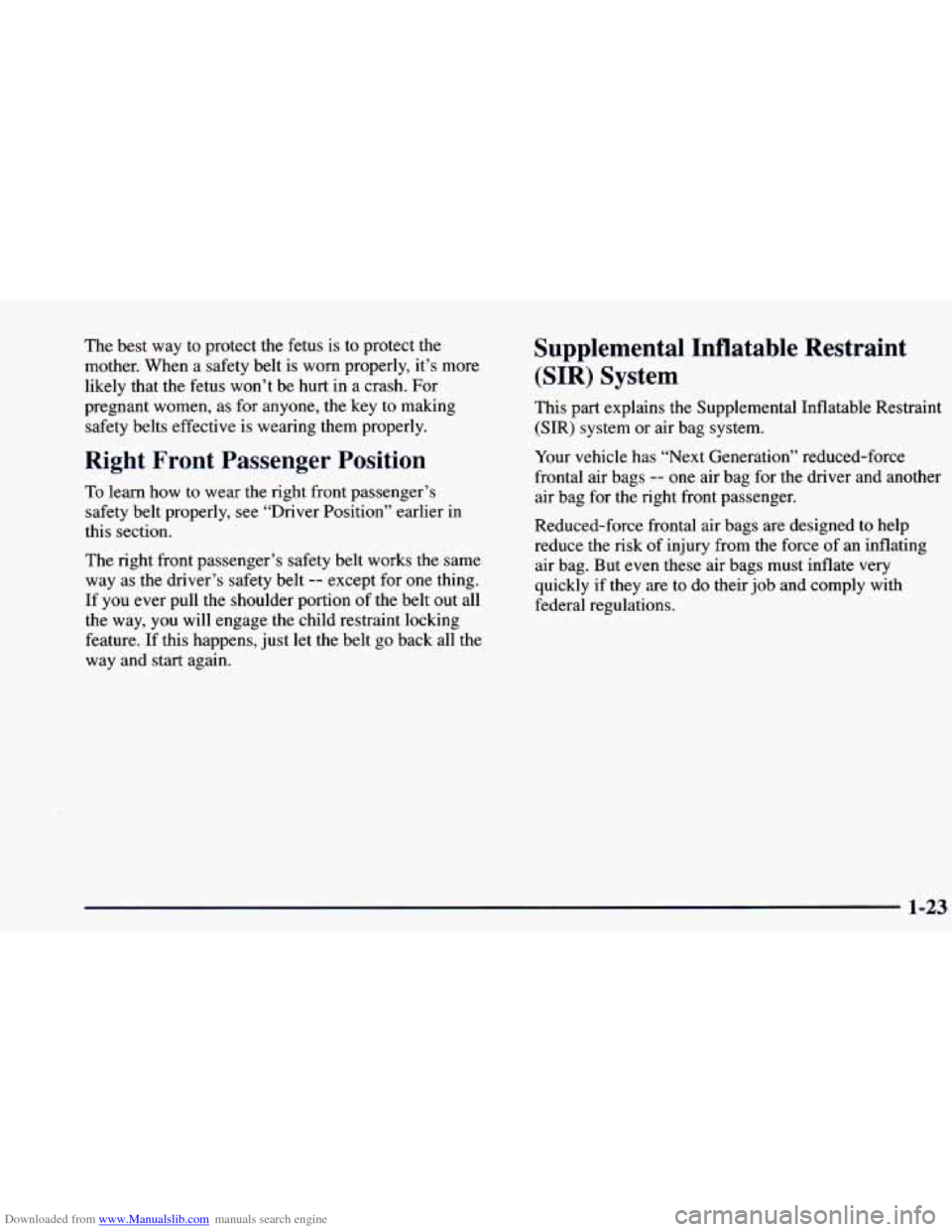
Downloaded from www.Manualslib.com manuals search engine The best way to protect the fetus is to protect the
mother, When a safety belt
is worn properly, it’s more
likely that the fetus won’t be hurt in a crash. For
pregnant women, as for anyone, the key to making
safety belts effective is wearing them properly.
Right Front Passenger Position
To learn how to wear the right front passenger’s
safety belt properly, see “Driver Position” earlier in
this section.
The right front passenger’s safety belt works the same
way as the driver’s safety belt
-- except for one thing.
If you ever pull the shoulder portion of the belt out all
the way, you will engage the child restraint locking
feature. If this happens, just let the belt go back all the
way and start again.
Supplemental Inflatable Restraint
(SIR) System
This part explains the Supplemental Inflatable Restraint
(SIR) system or air bag system.
Your vehicle has “Next Generation” reduced-force
frontal air bags
-- one air bag for the driver and another
air bag for the right front passenger.
Reduced-force frontal air bags are designed to help
reduce the risk of injury from the force
of an inflating
air bag. But even these air bags must inflate very
quickly
if they are to do their job and comply with
federal regulations.
1-23
Page 65 of 416
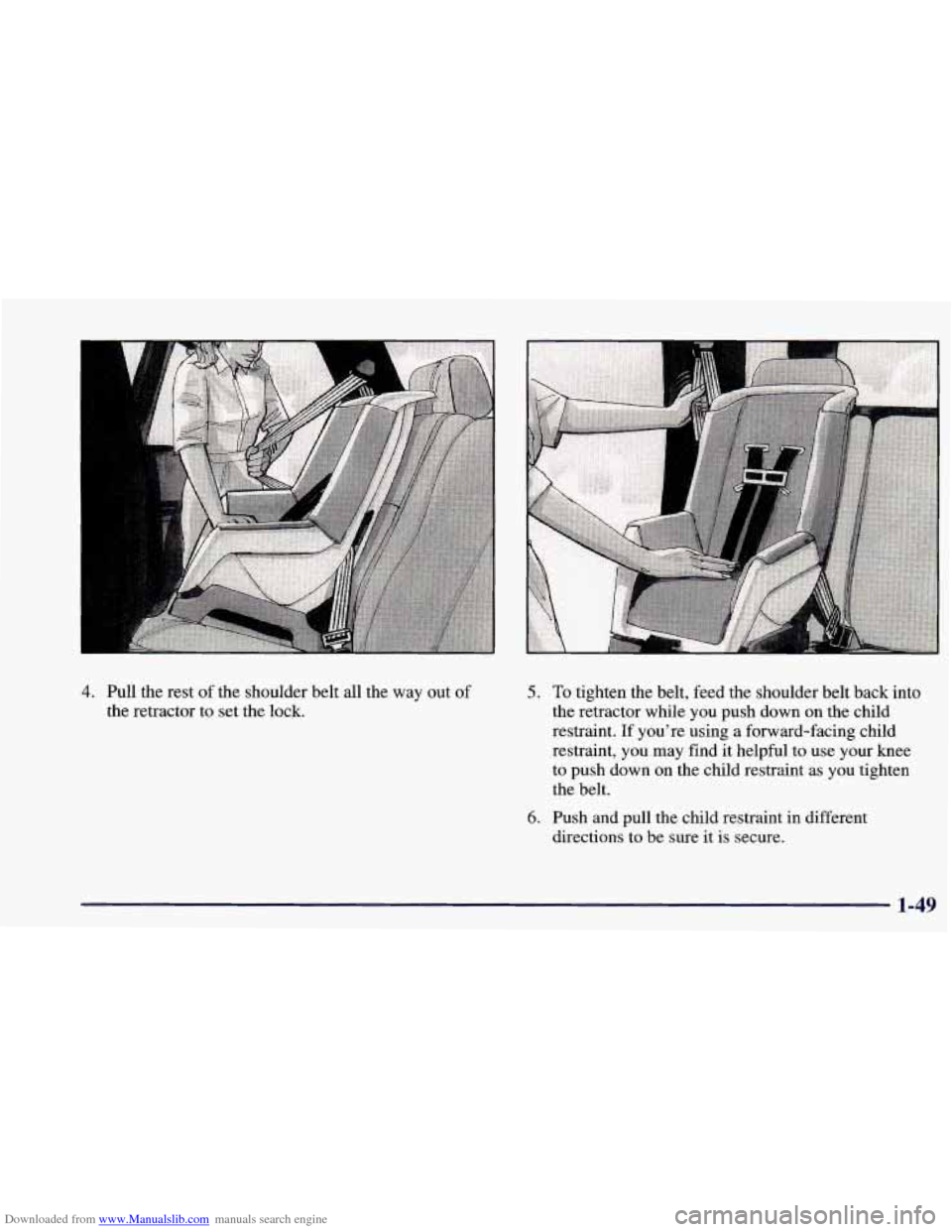
Downloaded from www.Manualslib.com manuals search engine 4. Pull the rest of the shoulder belt all the way out of
the retractor to set the lock.
5. To tighten the belt, feed the shoulder belt back into
the retractor while you push down on the child
restraint.
If you’re using a forward-facing child
restraint, you may find
it helpful to use your knee
to push down on the child restraint as you tighten
the belt.
6. Push and pull the child restraint in different
directions to be sure
it is secure.
1-49
Page 68 of 416
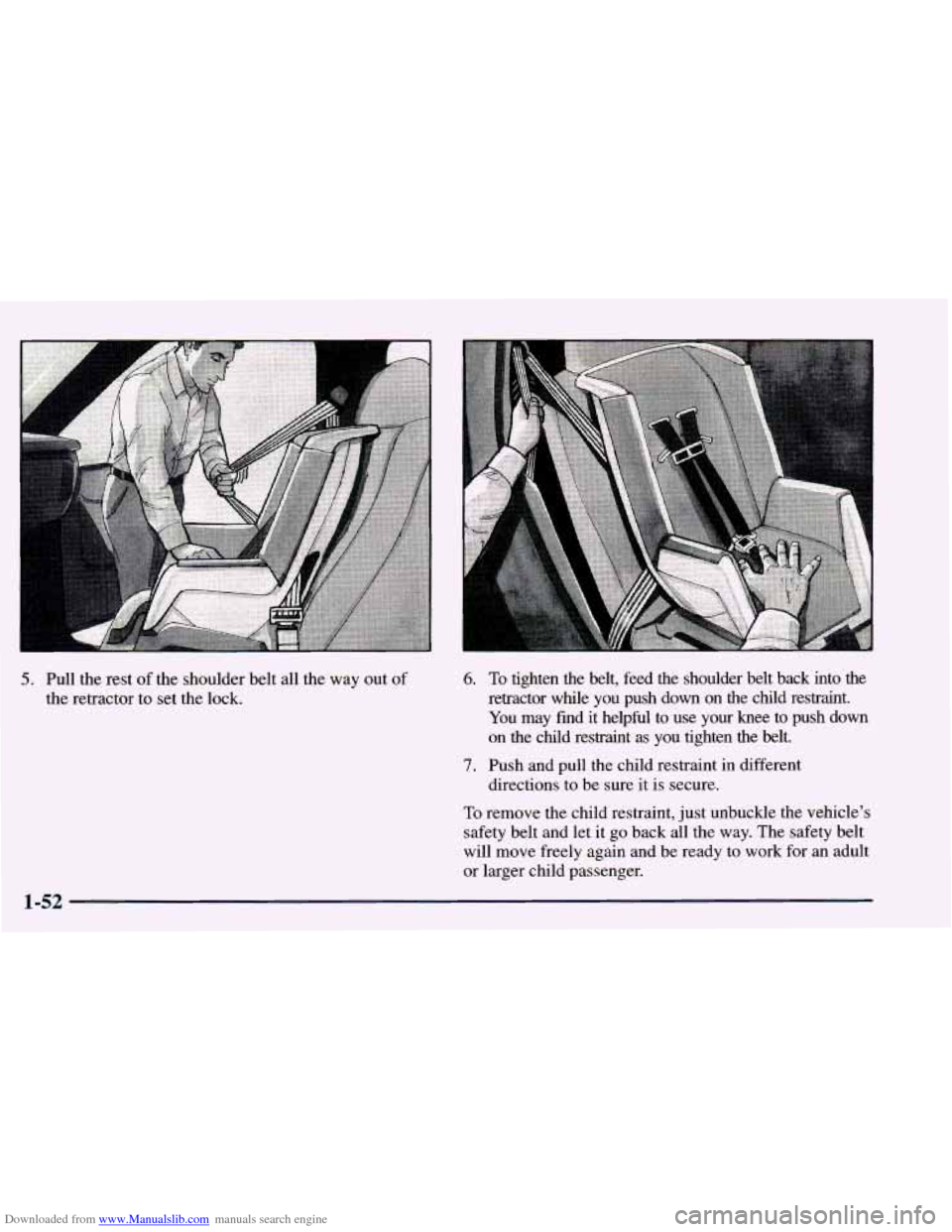
Downloaded from www.Manualslib.com manuals search engine 5. Pull the rest of the shoulder belt all the way out of
the retractor to set the lock. 6.
7.
To tighten the belt, feed the shoulder belt back into the
retractor while you push down on the child restraint.
You may find it helpful to use your knee to push down
on the child restraint as you tighten the belt.
Push and pull the child restraint in different
directions to be sure it is secure.
To remove the child restraint, just unbuckle the vehicle’s
safety belt and let it go back all the way. The safety belt
will move freely again and be ready to work for an adult
or larger child passenger.
Page 78 of 416
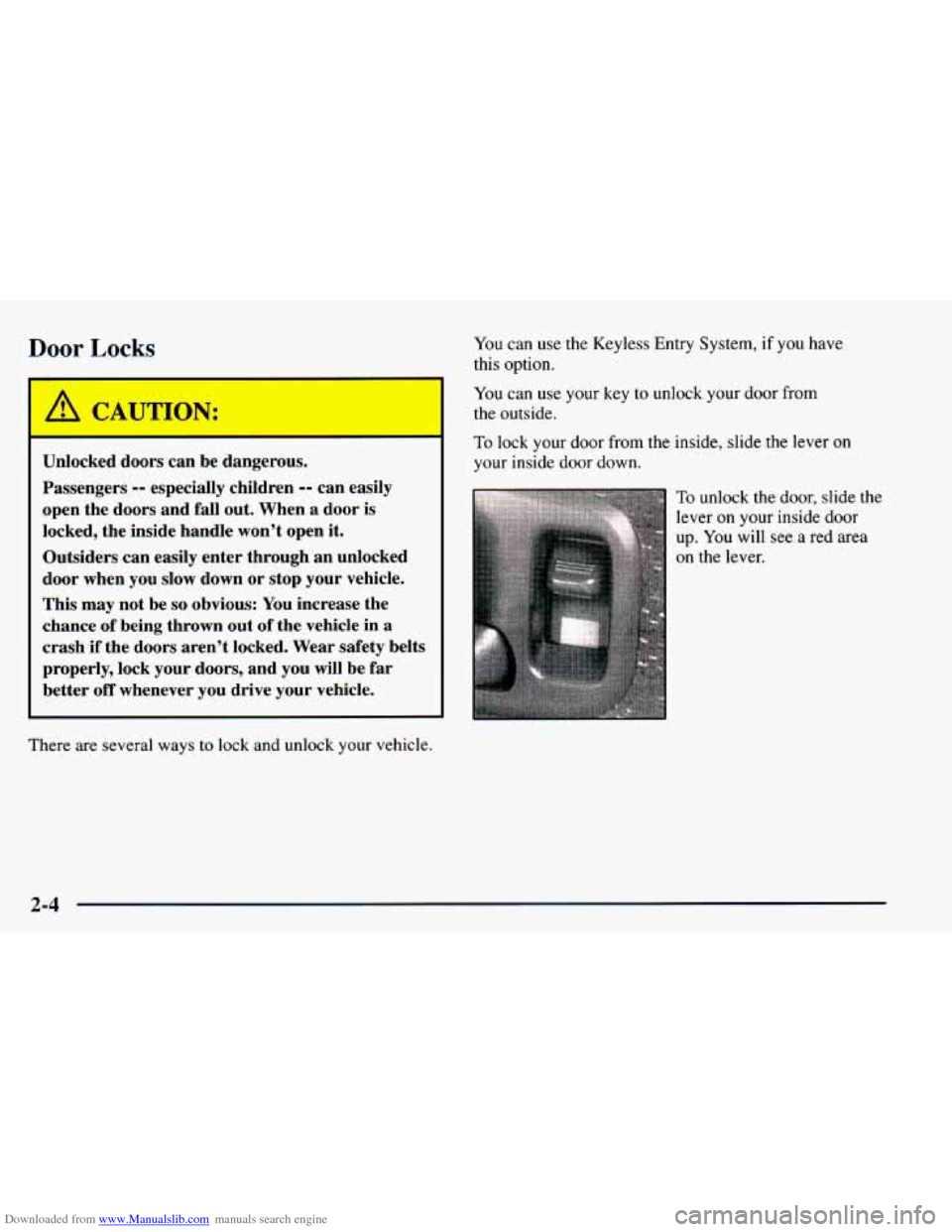
Downloaded from www.Manualslib.com manuals search engine Door Locks
Unlocked doors can be dangerous.
Passengers
-- especially children -- can easily
open the doors and fall out. When a door is
locked, the inside handle won’t open it.
Outsiders can easily enter through an unlocked
door when you slow down or stop your vehicle.
This may not be
so obvious: You increase the
chance
of being thrown out of the vehicle in a
crash if the doors aren’t locked. Wear safety belts
properly, lock your doors, and
you will be far
better off whenever you drive your vehicle.
There are several ways to lock and unlock your vehicle.
You can use the Keyless Entry System, if you have
this option.
You can use your
key to unlock your door from
the outside.
To lock your door from the inside, slide the lever on
your inside door down.
To unlock the door, slide the
lever on your inside door
up. You
will see a red area
on the lever.
2-4
Page 192 of 416
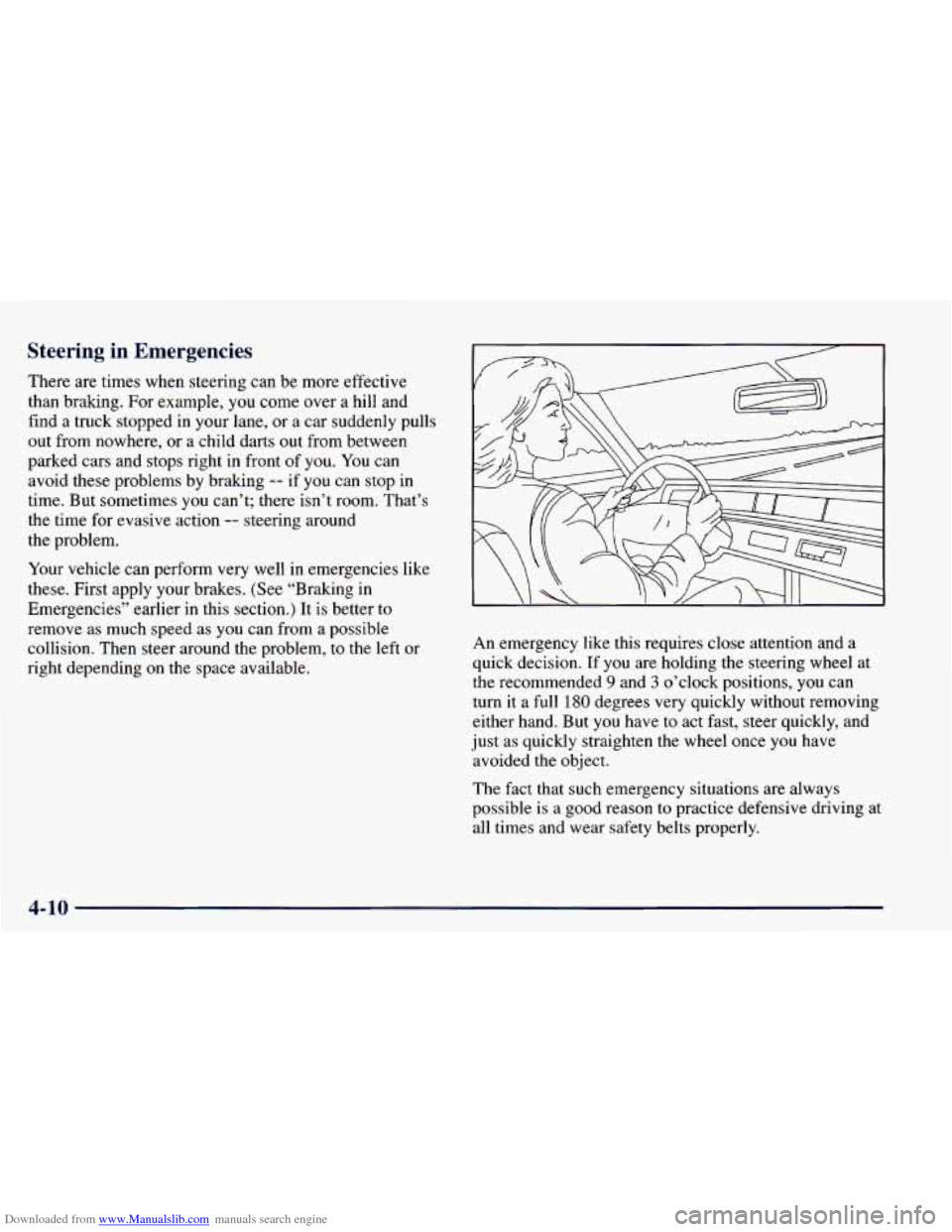
Downloaded from www.Manualslib.com manuals search engine Steering in Emergencies
There are times when steering can be more effective
than braking. For example, you come over a hill and
find a truck stopped in your lane,
or a car suddenly pulls
out from nowhere, or a child darts
out from between
parked cars and stops right
in front of you. You can
avoid these problems by braking
-- if you can stop in
time. But sometimes
you can’t; there isn’t room. That’s
the time for evasive action
-- steering around
the problem.
Your vehicle can perform very well in emergencies like
these. First apply your brakes. (See “Braking in
Emergencies” earlier in this section.) It is better to
remove as much speed as you can from a possible
collision. Then steer around the problem, to the left or
right depending on the space available. An emergency
like this requires close attention
and a
quick decision. If
you are holding the steering wheel at
the recommended
9 and 3 o’clock positions, you can
turn it a full
180 degrees very quickly without removing
either hand. But you have to act fast, steer quickly, and
just
as quickly straighten the wheel once you have
avoided the object.
The fact that such emergency situations are always
possible is a good reason to practice defensive driving at
all times and wear safety belts properly.
4-10
Page 402 of 416
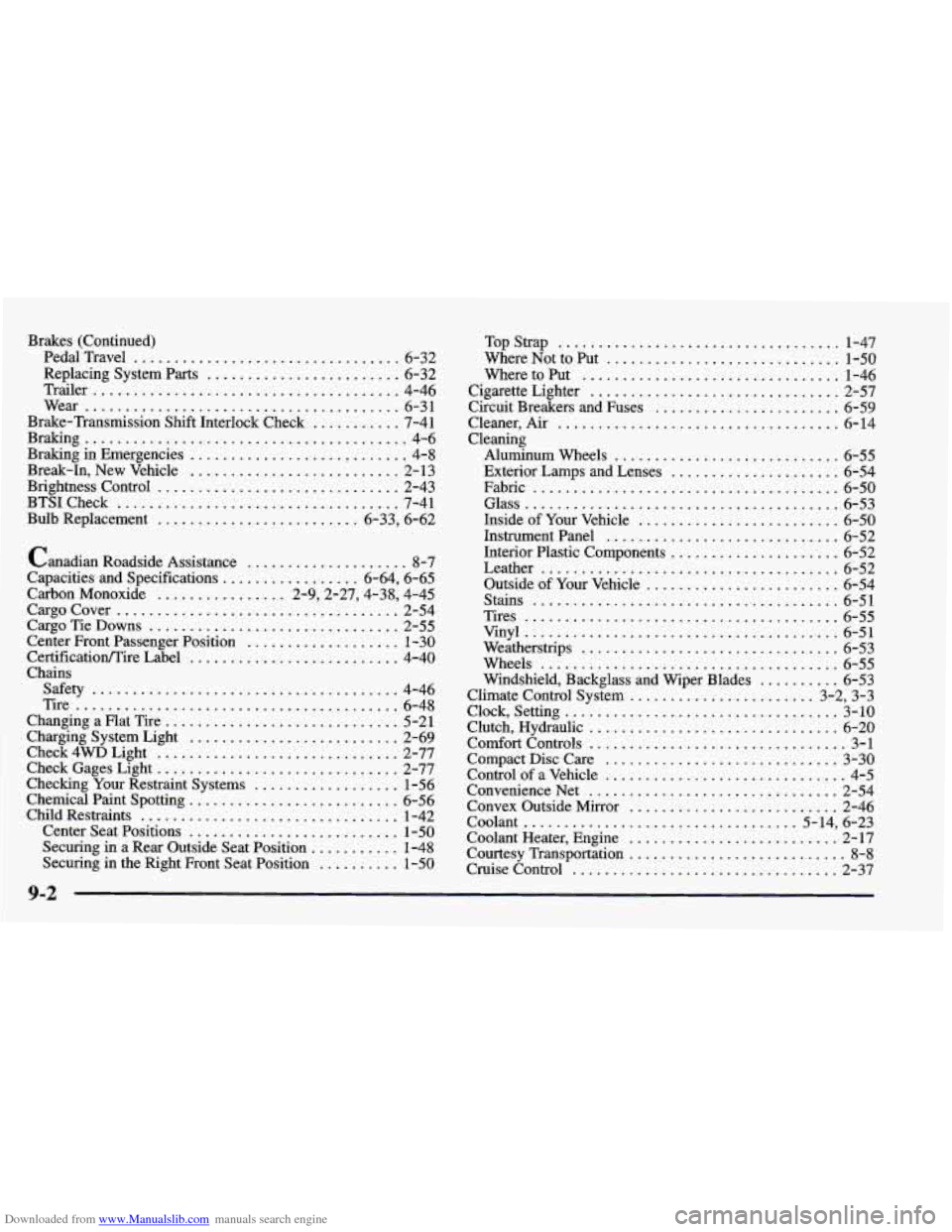
Downloaded from www.Manualslib.com manuals search engine Brakes (Continued) PedalTravel
................................. 6-32
Replacing System Parts
........................ 6-32
Trailer
...................................... 4-46
Brake-Transmission Shift Interlock Check
........... 7-41
Braking
........................................ 4-6
Braking in Emergencies
................... ....... 4-8
Break-In, New Vehicle
.......................... 2- 13
Brightness Control
.............................. 2-43
Bulb Replacement
......................... 6-33, 6-62
Wear
....................................... 6-31
BTSICheck
................................... 7-41
Canadian Roadside Assistance
.................... 8-7
Capacities and Specifications
................. 6.64. 6.65
Carbon Monoxide
................ 2.9.2.27.4.38. 4.45
Cargocover
................................... 2-54
Cargo Tie Downs
............................... 2-55
Center Front Passenger Position
................... 1-30
Certificatioflire Label
.......................... 4-40
Chains Safety
...................................... 4-46
Changing a Flat Tire
............................. 5 -2 1
Charging System Light
.......................... 2-69
Check
4WD Light .............................. 2-77
Check Gages Light
.............................. 2-77
Checking Your Restraint Systems
.................. 1-56
Chemical Paint Spotting
.......................... 6-56
Child Restraints
................................ 1-42
Center Seat Positions
.......................... 1-50
Securing in a Rear Outside Seat Position
........... 1-48
Securing in the Right Front Seat Position
.......... 1-50
Tire
........................................ 6-48 TopStrap
................................... 1-47
Where Not to Put
............................. 1-50
Where to Put
................................ 1-46
Cigarette Lighter
............................... 2-57
Circuit Breakers and Fuses
....................... 6-59
Cleaner. Air
................................... 6-14
Cleaning Aluminum Wheels
............................ 6-55
Exterior Lamps and Lenses
..................... 6-54
Glass
....................................... 6-53
Inside
of Your Vehicle ......................... 6-50
Interior Plastic Components
..................... 6-52
Outside
of Your Vehicle ........................ 6-54
Vinyl
....................................... 6-51
Windshield, Backglass and Wiper Blades
.......... 6-53
Climate Control System
....................... 3-2, 3-3
Clock, Setting
.................................. 3-10
Clutch, Hydraulic
............................... 6-20
Comfort Controls
................................ 3-1
Compact Disc Care
............................. 3-30
Control
of a Vehicle .............................. 4-5
Convex Outside
Mirror .......................... 2-46
Coolant Heater, Engine
.......................... 2-17
Courtesy Transportation
........................... 8-8
Cruise Control ................................. 2-37
Fabric
...................................... 6-50
InstrumentPanel
............................. 6-52
Leather
..................................... 6-52
Stains
...................................... 6-51
Tires
....................................... 6-55
Weatherstrips
................................ 6-53
Wheels
..................................... 6-55
ConvenienceNet
............................... 2-54
Coolant
.................................. 5-14, 6-23
9-2